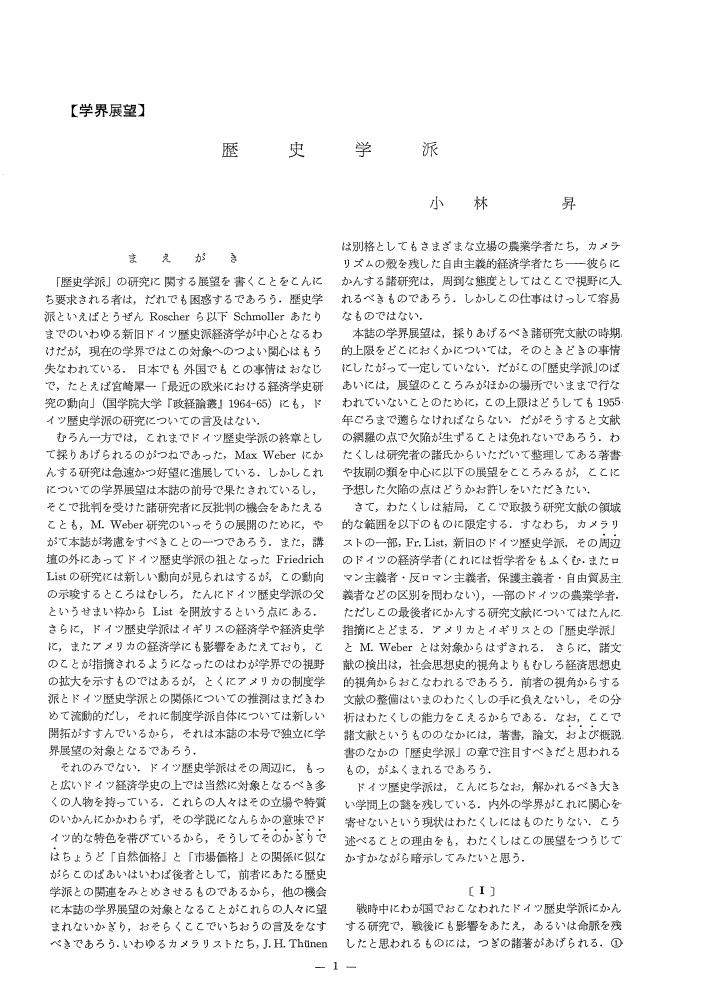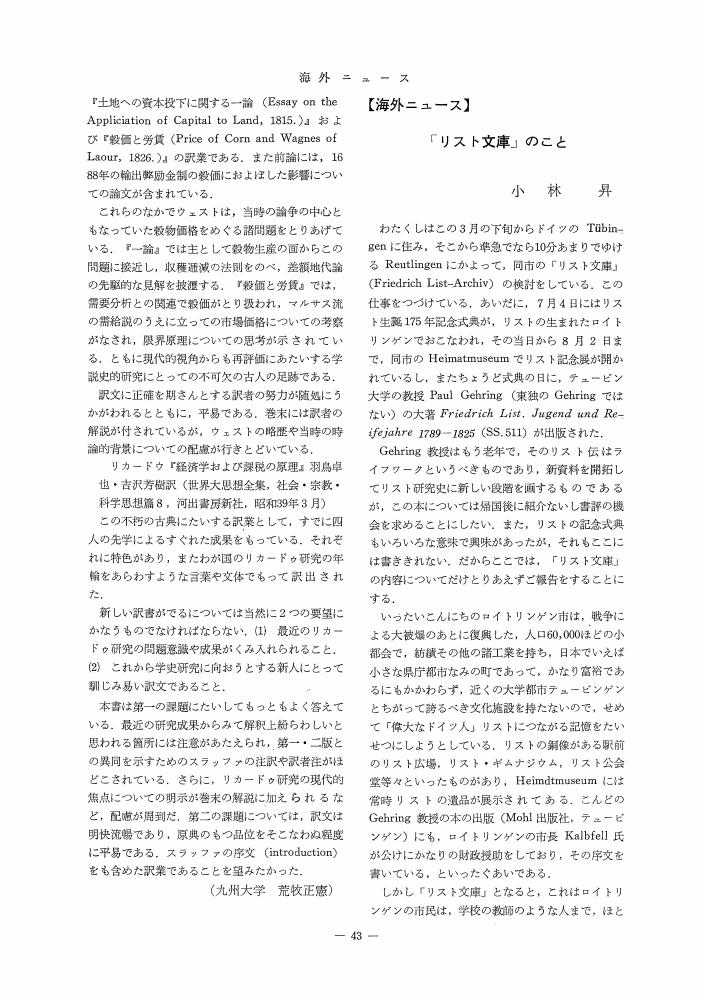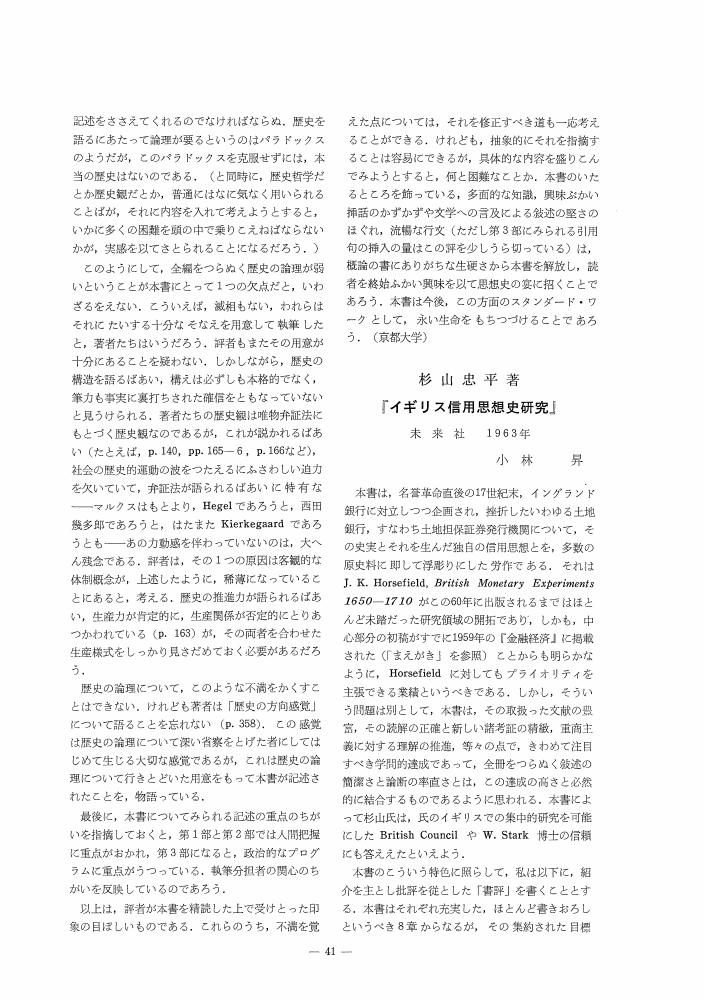2 0 0 0 OA アダム•スミスの「見えない手」について (平成七年十月十二日 提出)
- 著者
- 小林 昇
- 出版者
- 日本学士院
- 雑誌
- 日本學士院紀要 (ISSN:03880036)
- 巻号頁・発行日
- vol.50, no.3, pp.163-186, 1996 (Released:2007-06-22)
What I intend to do in this article is critically to examine Adam Smith's idea of‘invisible hand’, following the passages in which the phrase appears.As is known well, the phrase‘an invisible hand’appears three times, that is to say, once each in EPS, TMS and WN. Its appearance in EPS, however, does not imply any particular problem. And in the case of WN, there is also a place where the phrase is only implied, i. e. in its Book III, Chap. V (cf. A. Skinner, Introduction to the Pelican[Penguin]Classicsed. of the WN.).In TMS the phrase‘invisible hand’is made use of surrounded by the ancient Stoic creed on which the philosopher Smith is based. In that sense the phrase is outside the theory of sympathy which constitutes the basis of TMS, and the theory of so-called‘deception’used there in the sense that men's misfortune, mistakes and mere selfish acts contribute to the realization of the harmony of the whole society is not sufficient for the possibility of the formation of modern exchange economy society.In WN the phrase‘an invisible hand’totally implies a force to bring about an eventual harmony and welfare in the modern liberal society, and the function of this force is based on the formation of the theories of natural course (order) of the employment of capital. However, the collapse of the theory as such is evident. Moreover, since J. Viner's treatise pointed out, it is well known that Smith is not exhaustive in the criticism of so-called mercantilism, the work of the‘invisible hand’is confined.In Book III of WN, a transcendental power is talked of to cause a great revolution by its action on unworthy common men, where Smith's historical philosophy is evinced which somehow resembles Hegel's‘List der Vernunft’. But such a work in fact of the‘invisible hand’appears only once, and merely implicitly in WN so that Smith's elucidation here does not have universal validity.Quite naturally, the phrase‘an invisible hand’is a symbolic term which a particular age gave birth to and therefore, so far as it goes it can be the object of academic analysis but not its means.
1 0 0 0 OA リチャード•カンティロンとジェイムズ•ステュアート (平成一二年一〇月一二日 提出)
- 著者
- 小林 昇
- 出版者
- The Japan Academy
- 雑誌
- 日本學士院紀要 (ISSN:03880036)
- 巻号頁・発行日
- vol.55, no.3, pp.175-212, 2001 (Released:2007-06-22)
Ever since its 'discovery' by William S. Jevons toward the end of the 19th century, Richard Cantillon's sole published work, Essai sur la nature du commerce en général, 1755, has been given critical acclaim by such first-rate theoreticians as H. Higgs, J.A. Schumpeter, F. Hayek, T.W. Hutchison, and J.R. Hicks. It is widely recognized as an essential golden link between William Petty and Francois Quesnay in the history of economics. On the other hand, James Steuart's major work, An Inquiry into the Principles of Political Oeconomy, 2 vols., also published in the latter half of the 18th century, 1767, has long been neglected both in Great Britain and in France, and has been duely acknowledged only after the end of World War II. That it was given some notice in France during the French Revolution and translated into French by E.F. Sénover and published, and that even its another French translation was also completed (but not published) by Goguel, failed to secure a rightful place for Steuart in the history of political economy during his days and after.It is indeed of great academic interest and importance to place James Steuart in pre-Adam Smith political economy of the 18th century and to examine how Steuart's Principles is related with Cantillon's Essai, both positively and negatively. Because of the asymmetrical reception of these two works, however, this task has effectively only begun, and has thus far produced only A. Brewer's Richard Cantillon. Pioneer of Economic Theory, 1992. And it has recently been shown empirically by P. Groenewegen that the Cantillon to whom Steuart referred to was not Richard Cantillon but his brother-in-law, Philip Cantillon, and The Analysis o f Trade, 1759 by Philip explains in its inside of cover that the author followed Richard's work very closely, but it is of far inferior quality than the latter's Essai. Thus, it is hardly imaginable that Richard Cantillon's work had a direct impact on James Steuart's. However, within the context of chaos during the early phase of the establishment of political economy as a discipline in the 18th century, it is quite worth-while to examine whether or not Richard Cantillon had any indirect influence on James Steuart, and if so, in what forms.This being said, however, these two classics do not render themselves to ready comparison. Cantillon's Essai is characterized by the clarity and rigor of its purely theoretical analysis while Steuart's The Principles is an attempt at equally theoretical development but always on the basis of detailed historical and institutional, thus complex, reality of how national economies operated. Abundant fruit can be expected when today's observers free themselves from their narrow theory or theoretical outlook in assessing them.In this essay, I do not attempt a direct and detailed comparison of these classical masters. Instead I try to compare them on how they dealt with the following broader and urgent issues of political economy: a. the principle of wealth, b. population, c. money, d. industry, profit, and entrepreneur, e. circular flow, and f. the issues of economic liberalism versus mercantilism (or rather dirigisme in French context).We must also note that these two classical authors both were born outside England, obtained meaningful experiences particularly in France, and looked at the same subject matters of money, credit and the circular flow from their respective angles of observation. They are sure to give us fresh insights and perspectives on the so-called 'nationality of political economy' (Jevons).
1 0 0 0 IR バス用タイヤの車外騒音に関する調査
- 著者
- 尾崎 秀生 佐野 翼 野吹 幸男 林 昇
- 出版者
- 全国自動車短期大学協会
- 雑誌
- 自動車整備技術に関する研究報告誌
- 巻号頁・発行日
- no.11, pp.37-40, 1983-08
大型車両のスパイクタイヤ騒音は,ノーマルタイヤにくらべてかなり大きいであろうと予測して,バス用のスパイクタイヤとノーマルタイヤについて,通常定行状態での騒音を計測し比較検討した。その結果,スパイク騒音がとりたてて著しく高いとはいえず,むしろスパイクによる路面損傷の方に問題があるのではないかという事がわかった。
1 0 0 0 OA 「国富論」における歴史批判(1973)
- 著者
- 服部 正治 Robert Chapeskie 小林 昇
- 出版者
- The Japanease Society for the History of Economic Thought
- 雑誌
- 経済学史研究 (ISSN:18803164)
- 巻号頁・発行日
- vol.59, no.1, pp.63-90, 2017 (Released:2019-09-01)
Introduction by Masaharu Hattori The late Noboru Kobayashiʼs “Historical Critique in Wealth of Nations: A Per-spective on Books III and IV,” translated here into English, was originally pub-lished in Japanese in Fukushima Universityʼs Shōgaku Ronsyū (The Journal of Commerce, Economics and Economic History), Vol. 41, No. 5, 1973, and re-printed in Volume 2, which is indicated as 《II》 in this translation, 1976, of The Works of Kobayashi Noboru on the History of Economic Thought, 11 Volumes, 1976-1989, Tokyo: Miraisha. The “Historical Critique” of the title of this article has a double meaning when it comes to its content. In one sense, it refers to Smithʼs criticism of history that goes against the natural progress of opulence and has been seen in Europe “after the fall of the Roman Empire” that is de-scribed in Book III of Wealth of Nations. In another sense, it refers to Kobaya-shiʼs criticism of the defect inherent in Smithʼs historical understanding. When it comes to the latter, Smith did not sufficiently recognize the historical fact that the mercantilist protectionism of the Government of the civil revolutions (par-ticularly the Glorious Revolution) in Britain protected and fostered the devel-opment of domestic industrial capital, bringing about the bi-polar separation of independent producers that advanced the development of the primitive accumu-lation of capital and eventually led to the establishment of the capitalist system. Kobayashiʼs historical critique can thus be summarized as pointing out Smithʼs flawed understanding of the historical significance of mercantilism.
1 0 0 0 OA 『国富論』の学史的位置の相対化
- 著者
- 小林 昇
- 出版者
- The Japanese Society for the History of Economic Thought
- 雑誌
- 経済学史学会年報 (ISSN:04534786)
- 巻号頁・発行日
- vol.38, no.38, pp.13-20, 2000 (Released:2010-08-05)
This essay is a personal account of how an aspect of the post-1945 Japanese research in the history of economics has evolved, with emphasis on how I myself, through my own reading of Friedrich List, British Mercantilists, Josiah Tucker, and particularly James Steuart, as well as my discoveries of other noteworthy economic classics, unwittingly undermined, thus relativized, the dominant place commanded by one economic classic, Adam Smith, The Wealth of Nations. This was done within the prevailing academic atmosphere of the time, which was characterized by a predominance of Marxian orientation and a concentration on Adam Smith's studies since pre-1945 days, and a rather critical response to these two schools of thought. This post-WWII response, greatly facilitated by the Japan Society of History of Economics (established in 1950), contained some striking elements, such as the introduction of modern theories in the analysis of older economic treatises, Adam Smith studies being affected by expanded studies of the Scottish Enlightenment, and attempted new perceptions of the entire classical economics in view of the development of historical science and discoveries of various new materials, as well as conspicuous broadening of our horizon to include the Continental European and American scenes. In this process I gradually dissociated myself from the Marxian orientation in my reading of the history of economics.
1 0 0 0 OA アダム・スミス没後二百周年記念特集
- 著者
- 星野 彰男 関 源太郎 和田 重司 小林 昇 水田 洋
- 出版者
- The Japanese Society for the History of Economic Thought
- 雑誌
- 経済学史学会年報 (ISSN:04534786)
- 巻号頁・発行日
- vol.28, no.28, pp.11-41, 1990 (Released:2010-08-05)
- 参考文献数
- 80
- 著者
- 小林 昇
- 出版者
- The Japanese Society for the History of Economic Thought
- 雑誌
- 経済学史学会年報 (ISSN:04534786)
- 巻号頁・発行日
- vol.24, no.24, pp.61, 1986 (Released:2010-08-05)
1 0 0 0 OA W. O. Henderson, Friedrich List. Economist and Visionary 1789-1848, Frank Cass, London, 1983, 288pp.
- 著者
- 小林 昇
- 出版者
- The Japanese Society for the History of Economic Thought
- 雑誌
- 経済学史学会年報 (ISSN:04534786)
- 巻号頁・発行日
- vol.22, no.22, pp.51, 1984 (Released:2010-08-05)
1 0 0 0 OA 経済学史学会の30年を語る
- 著者
- 堀 経夫 出口 勇蔵 小林 昇 水田 洋 久保 芳和 杉原 四郎 田中 敏弘
- 出版者
- The Japanese Society for the History of Economic Thought
- 雑誌
- 経済学史学会年報 (ISSN:04534786)
- 巻号頁・発行日
- vol.17, no.17, pp.12-21, 1979 (Released:2010-08-05)
- 著者
- 小林 昇
- 出版者
- The Japanese Society for the History of Economic Thought
- 雑誌
- 経済学史学会年報 (ISSN:04534786)
- 巻号頁・発行日
- vol.9, no.9, pp.30-31, 1971 (Released:2010-08-05)
1 0 0 0 OA 歴史学派
- 著者
- 小林 昇
- 出版者
- The Japanese Society for the History of Economic Thought
- 雑誌
- 経済学史学会年報 (ISSN:04534786)
- 巻号頁・発行日
- vol.5, no.5, pp.1-6, 1967 (Released:2010-08-05)
1 0 0 0 OA 「リスト文庫」のこと
- 著者
- 小林 昇
- 出版者
- The Japanese Society for the History of Economic Thought
- 雑誌
- 経済学史学会年報 (ISSN:04534786)
- 巻号頁・発行日
- vol.2, no.2, pp.43-48, 1964 (Released:2010-08-05)
1 0 0 0 OA 杉山忠平著『イギリス信用思想史研究』未来社 1963年
- 著者
- 小林 昇
- 出版者
- The Japanese Society for the History of Economic Thought
- 雑誌
- 経済学史学会年報 (ISSN:04534786)
- 巻号頁・発行日
- vol.1, no.1, pp.41-45, 1963 (Released:2010-08-05)
1 0 0 0 OA 8. 原子力利用
- 著者
- 中杉 秀夫 林 昇一郎 渡辺 喜亮 中杉 秀夫 船矢 敏朗
- 出版者
- 一般社団法人 日本エネルギー学会
- 雑誌
- 燃料協会誌 (ISSN:03693775)
- 巻号頁・発行日
- vol.61, no.8, pp.643-668, 1982-08-20 (Released:2010-06-28)
- 参考文献数
- 21
1 0 0 0 OA 山口県西部地方のウラン鉱床
- 著者
- 林 昇一郎
- 出版者
- 一般社団法人 日本原子力学会
- 雑誌
- 日本原子力学会誌 (ISSN:00047120)
- 巻号頁・発行日
- vol.10, no.8, pp.444-448, 1968-08-30 (Released:2010-04-19)
- 参考文献数
- 9
A weak radioactive anomaly (0.080mR/hr) was detected at Yuya in 1959, but since then no furthur efforts in prospection have been undertaken in the area, since at that time it was not customary to attach much value to such occurrences. In November, 1966, significant radioactivity (1.7mR/hr, 0.6% U3O8) was detected 35m south of the previous location, in the course of a systemafic car-borne radiometric survey undertaken by the Atomic Fuel Corporation of Japan. To date, several uranium occurrences have been discovered in formations belonging to the Cretaceous Period. This is the first instance of such occurrence in Cretaceous formation discovered in Japan.The Yuya uranium deposits occur mainly in dark gray to brown, hard compact sandstone and/or sandy shale. The deposits appear related to rhyolitic rock intrusions. A secondary uranium mineral, believed to be autunite, is sporadically found in the black silicified sandstone closely associated with pyrite and chlorite. Little uranium would appear to be contained in such clay minerals as chlorite according to radioluxograph and X-ray fluorescent examination, since primary uranium minerals have not yet identified.So far prospection for uranium deposits in Japan have been directed mostly to the Neogene Tertiary just above the granitic host rocks. The discovery of the Yuya deposits in Cretaceous formation is highly significant in that it has opened up a vast new area to prospection in strata other than Tertiary formation, and this urges us to continue our efforts in gathering further information that should contribute to a better assessment of the domestic uranium potentiality.
1 0 0 0 連続体力学に基づいた1次元差分法による侵徹現象の分析について
- 著者
- 野間 俊人 国重 博史 大林 昇
- 出版者
- 防衛庁技術研究本部技術部
- 雑誌
- 技術研究本部技報 (ISSN:04359895)
- 巻号頁・発行日
- no.965, pp.p1-43, 1986-08
山形市内およびその周辺に現存する義川斎と文嶺の作品調査を実施した。写真撮影を行い、文嶺の作品の内すでに写真撮影のすんでいるものとあわせ、ふたりの作品を集成した。つだ、山形市史編纂史料など江戸時代の山形城下に関する文献史料や義川斎と文嶺ゆかりの寺社の古文書などを調査した。義川斎の作品として、小白川天満神社の絵馬や竜門寺山門の天井画などを確認した。これらの寺社は山形市内では代表的な寺社である。また、1820(文政3)年に出版され、当時の山形城下周辺の観光案内書ともいうべきものである『湯殿山道中一覧』をてがけるなど、山形城下では相当需要の高い絵師であったことがうかがえる。一方、文嶺の作品について、道内のものはすでに確認したところであるが、山形市内においては、代々紅花商を営む旧家や庄屋であった旧家など当時の有力者の家に伝わる作品を確認した。さらに、義川斎・文嶺がともに山形城下周辺の有力者が興じていた俳句会に参加していて、その俳句集の挿絵を描いていることも判明した。また、山形城下に店を構え、紅花を中心に扱っていた近江商人のひとりで、1821(文政4)年に松前にわたり、後に小宿となる山形屋八十八と親交があったことが、山形市史編纂史料から見つかった。山形八十八との関係は、文嶺が松前に移り住む背景となっていることが考えられる。
1 0 0 0 松前の絵師・早坂文嶺の画業とその作品について
幕末期の松前を中心に活動した画家,早坂文嶺の経歴については,これまで、河野常吉による「松前藩の画師なり。奥州福島の人にして,弘化中松前藩に仕へ士籍に列す。最も仏画を善くす。其の蝦夷人を描くときは,殊に二司馬の号を用ふ。即ち夷語ニシパ,貴人の義,に採るなり。子元長は,明治元年正議派の一人たり」以上のことは不明であった。ただし,文嶺を四条派の画家である前川文嶺(1837・天保8年〜1917・大正6年)とする指摘があり,すでに資料目録など一部でそのように記載したものもみられた。しかし、本研究において、文嶺は1797(寛政9)年に生まれ、1867(慶應3)年に享年71歳で没したことや、松前に移り住む前に山形城下の旅籠町で表具屋を家業としていたこと、さらに,文嶺の父は山形市内に作品が相当数現存かる画家で、義川斎定信などと号していたことなどが判明した。作品については,文嶺の活動の本拠地であった松前町をはじめ青森県風間浦村やさらにはアメリカ合衆国ブルックリン美術館所蔵資料をふくむ24点を確認することができた。その中で年紀を有する作品は7点あり、それらは弘化および安政年間であった。これまで、文嶺はおもにアイヌ絵の作者として紹介されることが多かったが,アイヌ絵以外にも仏画や武者絵など,その画題は幅ひろい。画風としては,狩野派や浮世絵の影響が顕著であるが、四条派などの画風も見受けられる。ひとつの流派に位置づけることはかなりむずかしいが、技量的にはけっして低くはないと思われる。
1 0 0 0 OA スカートの揺動によるリズム感の官能検査
- 著者
- 熨斗 秀夫 小林 昇二 山田 照幸
- 出版者
- 繊維学会
- 雑誌
- 繊維学会誌 (ISSN:00379875)
- 巻号頁・発行日
- vol.33, no.9, pp.T470-T477, 1977-09-10 (Released:2008-11-28)
- 参考文献数
- 3
- 被引用文献数
- 1
The sensory value for rhythm according to moving skirt were obtained by sensory test. The moving type of skirt is circular arc-reciprocation and skirt is dressed on the nude damy.The obtained results are as follows.(1) The relation between the moving type and sensory value for rhythm.(a) When the velocity of reciprocation is about 40cycle/min, the maximum sensory value for rhythm on each arc angle is obtained, in case of range of arc angle 30°C-170°C.(b) The maximum sensory values are classified into two groups. In the first group, the sensory values on each arc angle increase with increasing the arc angle, and in the second group, those become nearly same in spite of the arc angle.(2) The effect of the kinds of cloth and the constructive factors on skirt for the sensory value of rhythm.(a) In case the train-circumference of skirt is long, the sensory value becomes large.(b) The length of skirt gives little effect on the sensory value.(c) The properties of cloth give a little effect on the sensory value.In case both the length and the train-circumference of skirt are long, the sensory value under thick cloth becomes large, and in case both are short, the sensory value under thin cloth becomes large on the contrary.(d) The sensory value of rhythm becomes large, in case the node on skirt is deep.








